System Architect®
UNICOM System Architect is a market-leading enterprise architecture tool that enables you to build and automatically generate data-driven views of your organization's enterprise architecture -- its strategy, business architecture, operational architecture, data, application landscape, supporting systems, technologies, and infrastructure.
Together, these views form a mosaic that delivers the insight and analytics necessary to describe current and future states of the enterprise along with interdependencies, risks, life cycles, and standards.
And from that – you can “ask the architecture questions” – and know how good the answers are based on viewing the health of the architecture itself – what it’s missing, how old it is, where its sources of record lie, and who made changes to the architecture and when.

Empowered with this knowledge, your executives, decision makers, and managers can quickly and more effectively plan initiatives for improvement, due to a more thorough understanding of the reward, impact, roadmap, and risk of changes. You gain visibility of planned initiatives from the business through operations, solution architecture development, release management, and deployment (DevOps).
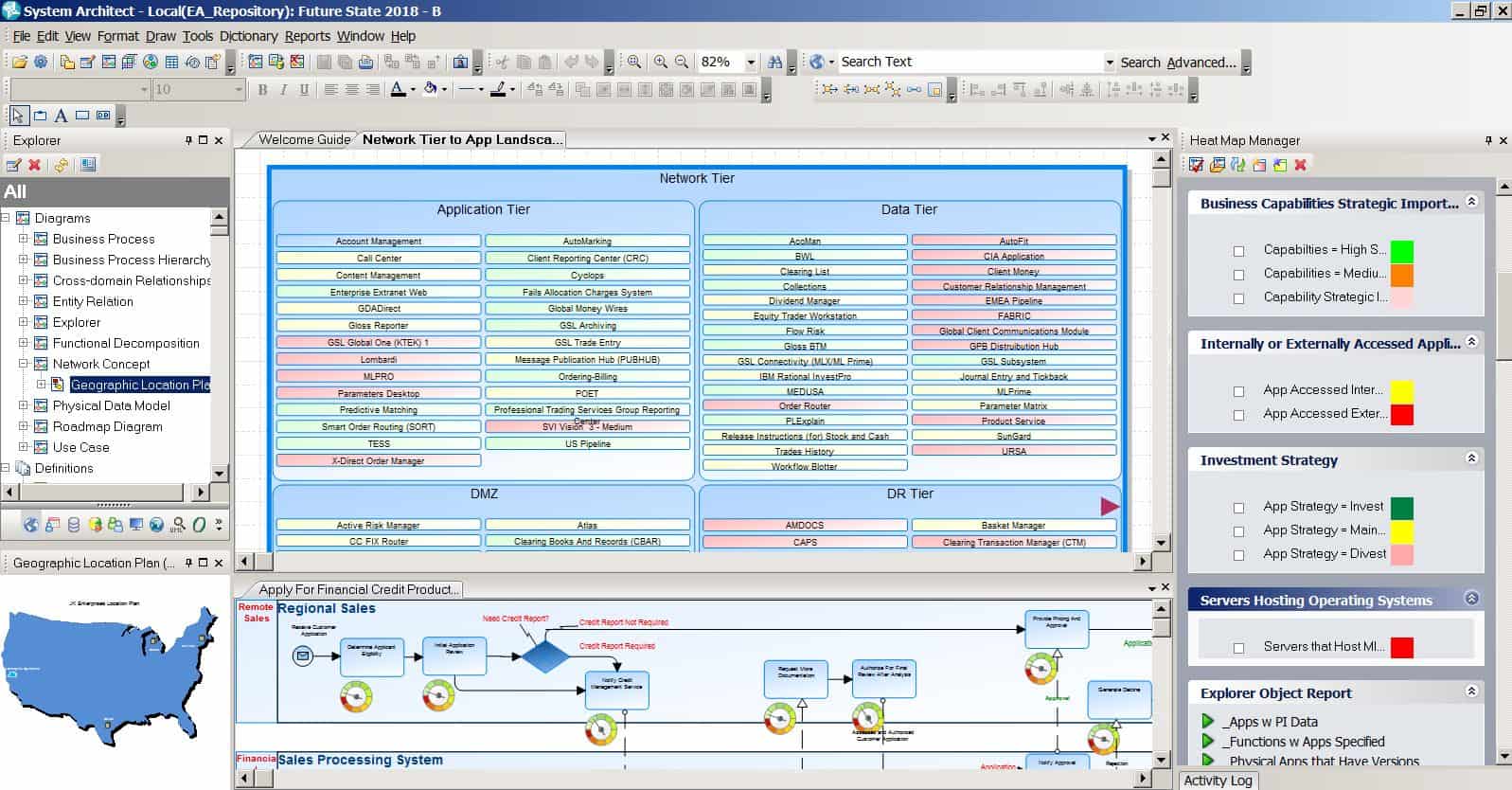
System Architect powerful rich client
With System Architect you can:
- Easily customize the metamodel of industry standard frameworks to match sources of record
- Automatically import those sources of record to quickly build a working Enterprise Architecture that you can ask questions of, and understand how good the answers are.
- Build capability-driven enterprise architectures
- Create a line of sight from strategies to key capabilities to systems and technologies supporting them.
- Take advantage of disruptive technologies and plan migration to the cloud.
- Use industry-standard frameworks and patterns.
- Perform master data management.
- Create roadmaps of business transformation.
- Produce dashboards to gain clear understanding of the big picture.
- Perform Business Process Analysis with Simulation and Optimization
- Build operational and system architectures with defense architecture frameworks
- Use market-leading support for TOGAF, ArchiMate, DoDAF 2, UAF, NAF, and MODAF.
- Build architectures using the Federal Enterprise Architecture Framework (FEAF 2).
- Integrate with UNICOM Focal Point for portfolio management.
- Reverse-engineer and analyze ERP systems such as Salesforce.com and SAP
- Allow each user to create custom dashboards of the EA in SA XT, the web client.

SA XT web client – create custom dashboards per user, view live reports of the architecture, draw diagrams in the web browser, and build reports on the fly in a wizard to "ask the architecture questions".
Existing Customer? Click here for System Architect Customer Registration
Click here to read about the latest release of System Architect 11.4.11.1
Click here to read about the latest release of System Architect 11.4.11
Click here to read about the latest release of System Architect 11.4.10.2
Click here to read about the latest release of System Architect 11.4.10.1
Click here to read about the latest release of System Architect 11.4.10
Click here to read about the latest release of System Architect 11.4.9.2
Click here to read about the latest release of System Architect 11.4.9.1
Click here to read about the latest release of System Architect 11.4.9
Microsoft Windows August 2019 Security Update Causing 'Runtime Error 5' Issue and Resolution
Press Release: UNICOM® Global Acquires IBM® Rational® System Architect from IBM Corp.
Enterprise Architecture
Build Strategy and Business Capability Maps
Build Strategy and Business Capability Maps and align aspects of the business and new technology investments to them. Create line-of-sight views from strategy through capability, business service, and the applications and infrasture that support it. Run analytics to understand risk, cost, and best solution approaches.

Business Capability Map and Business Capability Hierarchy views, with analytics applied showing strategic alignment of Capabilities and cost of underlying Applications (via Business Services).
Use Full-Featured Web Client
Use either the System Architect rich client or the SA XT thin web client to build or edit models of the enterprise architecture.

Build or edit diagrams or definitions in the SA XT web client.

Customer quoteBest architecture tool. I have used a number of tools but none have the richness of functionality as System Architect. Enabled us to customize the metamodel to the depth and breadth needed to support our own EA method and capture all of our sources of records. The built-in reporting is easy to use and enables us to produce rich output and perform analytics on the architecture. Just a great and robust tool."
Gartner's Peer Insights program
Use Industry-Standard Frameworks, Patterns, & Methods
Use industry-standard frameworks such as TOGAF, ArchiMate, DoDAF 2, Unified Architecture Framework (UAF), or NATO Architecture Framework (NAF), and adjust it to suit your needs using System Architect's renowned customizable metamodel.
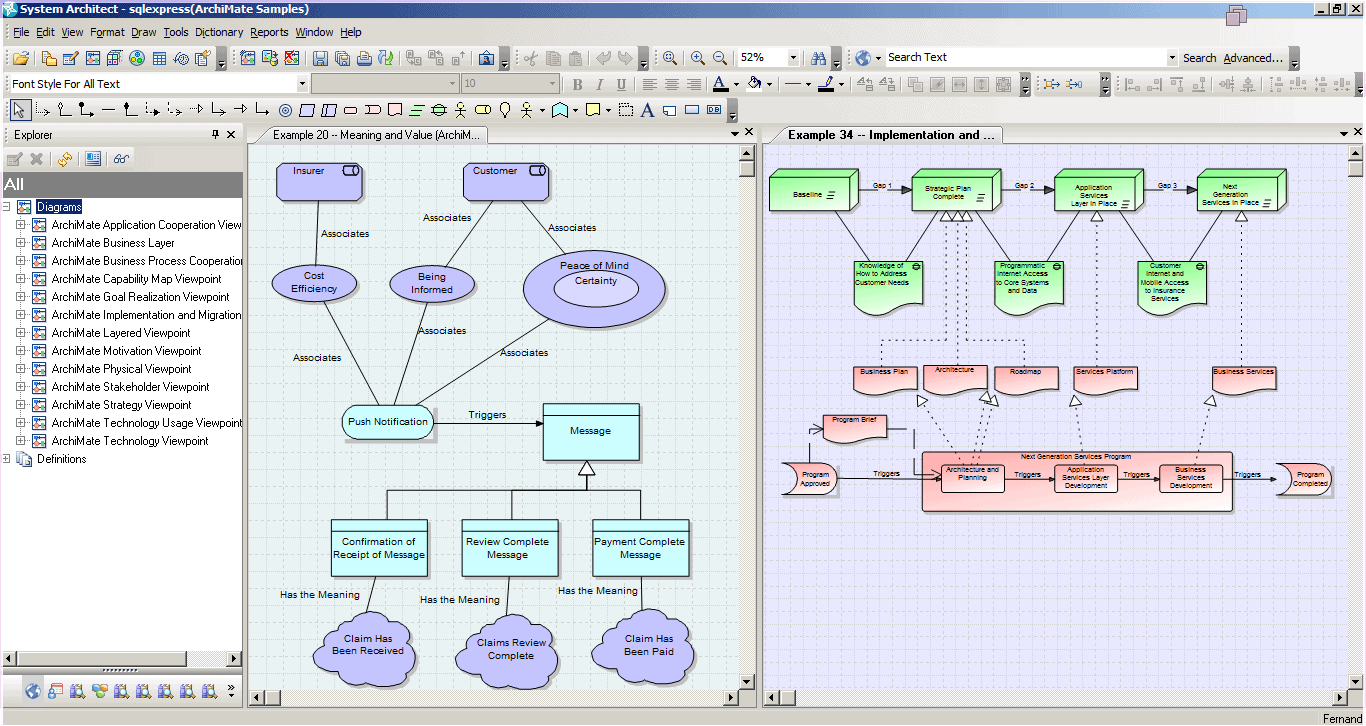
Native ArchiMate 3 add-on supports all the viewpoints of the popular framework.
Jump start the architecture by reusing industry-standard patterns such as the TMForum Frameworx business process (eTOM), services (SID), and application portfolio (TAM). Or use the APQC processes to jump start your business process analysis. Use the IBM Garage Method templates to architect your digital transformation.
Commercial or Federal enterprise architects can utilize the US Government Federal Enterprise Architecture Framework (FEAF 2) to prepopulate your repository with the business functions, services, applications, data, and security architecture that US agencies align their investments to. Federal enterprise architects can use FEAF 2 to perform the Consolidated Reference Method.
Customize Metamodel and Automatically Capture Sources of Record
A key enabler of enterprise architecture is being able to customize the metamodel to match sources of record, so that you can properly capture enterprise information. System Architect is unmatched in the industry for its ability to customize its metamodel to great breadth, depth, and ease. Easily add new properties to existing definition types to match sources of record; create new definition, diagram, symbol, and relationship types with model-centric rules; or create an entirely new framework to match an in-house EA method. Customizations can be done now and into the future of your EA journey; customizations are never impeded upon by new released versions of the tool.
Use SA’s open API for REST or COM with built-in VBA 7.1 to automatically harvest information from sources of record, or simply import information from spreadsheets via CSV or XML.
Utilize a Data-Centric or ‘Model-Based’ Approach
The enterprise architecture repository becomes a single source of the truth, harvesting information from disparate sources of record, with a data centric approach so that all diagram views and matrices represent your corporate information.
Use EA to Move to the Cloud
Enterprise Architecture is a fundamental tool to develop a cloud roadmap: strategically and tactically plan what appliications to move to the cloud, and when -- to gain cost and efficiency advantages, and to understand the risk involved. EA allows you to go beyond Application Portfolio Management to understand application interrelationships, what applications must be moved together; and what the advantages and risks are for re-architected or new cloud-native apps.
Perform Master Data Management
System Architect's strong data modeling capabilities, with logical and physical data models, and an underlying data dictionary integrated with business processes (BPMN) or data flow techniques, enable you to establish an unambiguous vocabulary of the data being worked on and created by the applications that the solution teams are developing.

Analyze Salesforce.com, SAP, and other ERP Systems
The SA ERP add-in enables you to reverse engineer ERP systems to analyze their data model tables, and their related application components and processes. Select important parts of the ERP data model (and its applications and processes) to import into System Architect, where its strong data modeling capabilities enable you to analyze the data model of the ERP system within the scope of the EA. This is a feature unique in the enterprise architecture world.

Generate Roadmaps of Future State Capabilities & Technologies
Generate forward-looking views of applications and technologies to understand rationalization and upgrades to guide your budgeting process. Build capability roadmaps to understand when new capabilities can be fielded and their dependencies on applications and technologies.
Build and Compare Current State & Future State Architectures
Baseline your enterprise architecture and create multiple side-by-side future-state architectures using a feature called workspaces, which are layers of the architecture. Compare future-state architecture alternatives side-by-side, selectively merge contents, and at some point baseline a desired future-state architecture to become a new current state, and create new future-state architectures. Workspaces enable different departments to work on the architecture independently, and then merge their work into the corporate EA.
Cause-Effect and Landscape Heatmap Analysis
Quickly get a 50,000-foot view of the architecture through System Architect's unique Network- and Landscape-style Explorer diagrams, that allow you to auto-visualize reports showing calculated (inferred) relationships between EA artifacts. For example, visualize what Capabilities are put at risk by Application versions utilizing technologies that have a security risk in an automatically generated network traceability diagram.

Or automatically create a landscape heatmap with Application versions placed inside the Capabilities they enable (and not showing the in-between element types). The EA world is your oyster with Explorer diagrams, which enable you to create visualizations of any combination of architecture elements on the fly in minutes.
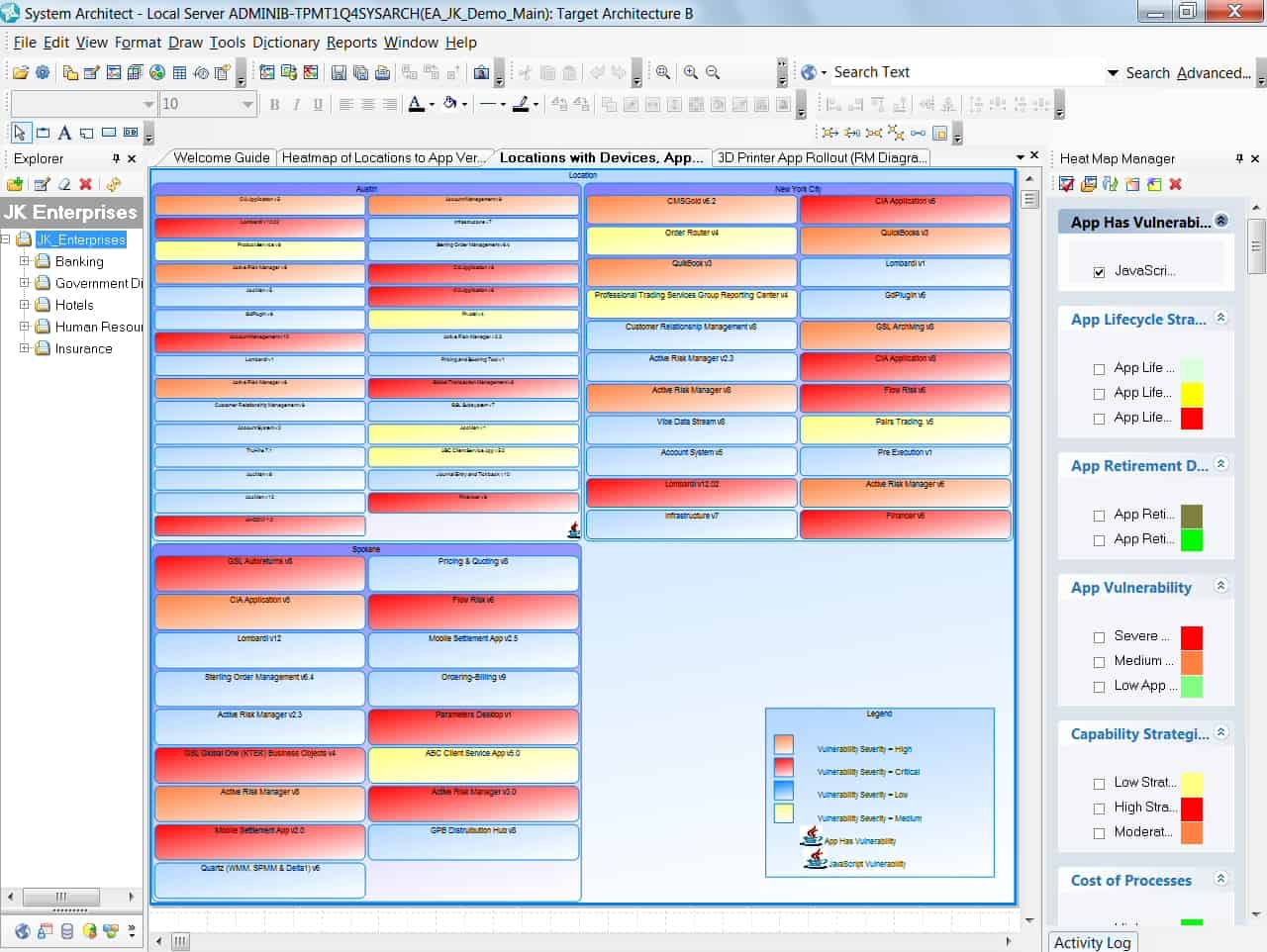
Perform Application Portfolio Analysis
Utilize out-of-box analytics to visualize portfolio analysis or write your own analytics on the fly in seconds using a wizard front end to the built-in SQL reporting system. Map decision analysis results into System Architect from UNICOM Focal Point using the integration between the tools, or map in APM measures from other industry-leading Project and Portfolio Management tools.
Integrate to Solution Design, Requirements, and Change Management
System Architect is one of the few enterprise architecture tools to embrace and implement Open Service for Lifecycle Collaboration (OSLC) standards. You can create traceability links between the architecture and related aspects of enterprise information such as requirements, change requests, action items, or solution designs in other architecture tools. A simple right-mouse click enables you to see information in other 'friend' tools across the network and create links to relevant artifacts in them, then see and navigate those links at any time. OSLC creates a federated picture of corporate information and helps make Enterprise Architecture more valuable, helping you take it out of its ivory tower. Use this traceability to govern solution design, and align to the DevOps processes of release management, testing, and deployment.
BPA & Simulation
Blockchain. Microservices. DevOps. Agile. Security. Regulation. Digital Transformation. Mergers and Acquisition. They all have one thing in common: to get a handle on these opportunities, events, or initiatives --organizations are using Business Process Analysis to understand current state and best way to get to future state.
Business Process Analysis allows you to understand the context of business problems to identify solutions, and to understand how key business processes will change due to new capabilities and technologies.
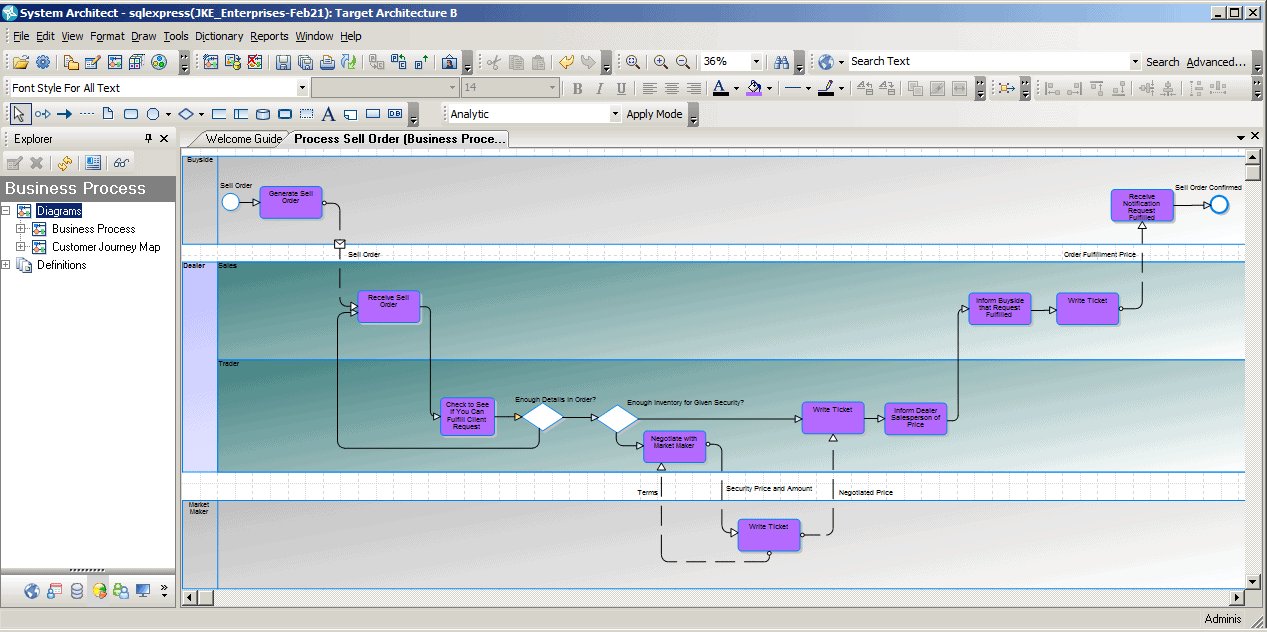
System Architect enables your team to do Business Process Analysis using the Business Process Modeling Notation (BPMN 2.0) in its rich client and have other team members model in BPMN in the same EA repository using the web client SA XT.
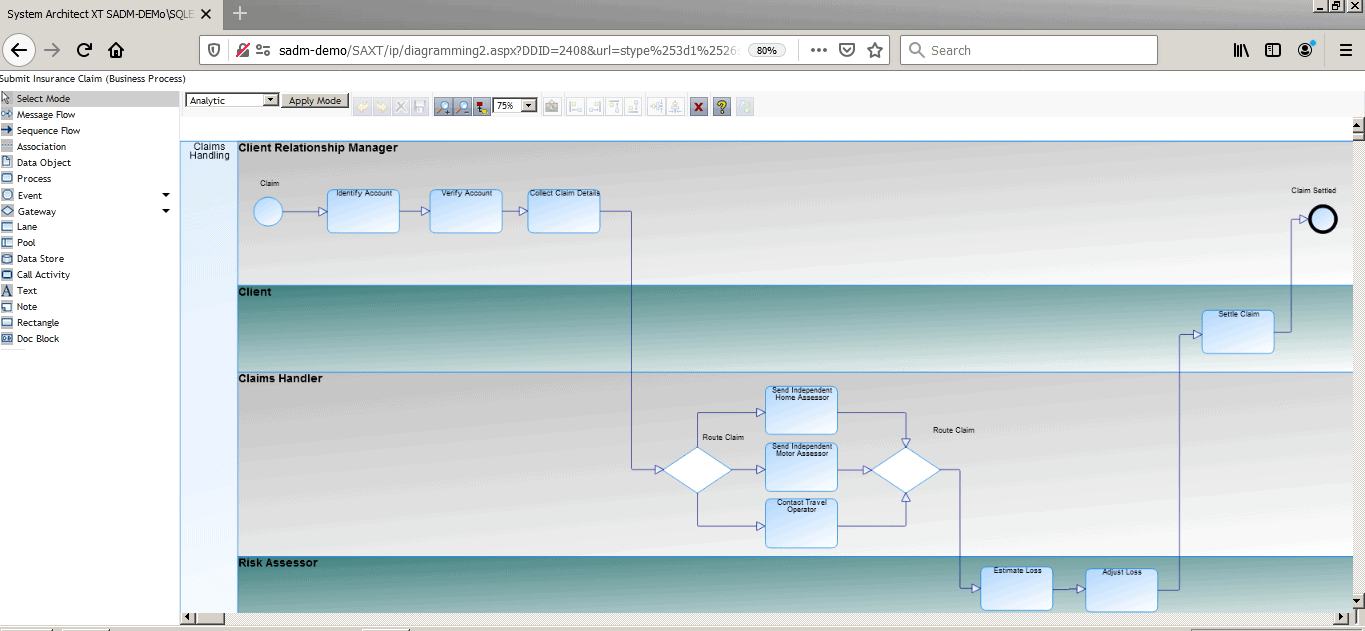
In some industries, documenting processes is mandatory to meet regulations. In all industries, publishing processes to the corporate intranet enables better communication of information and efficiencies in getting work done.
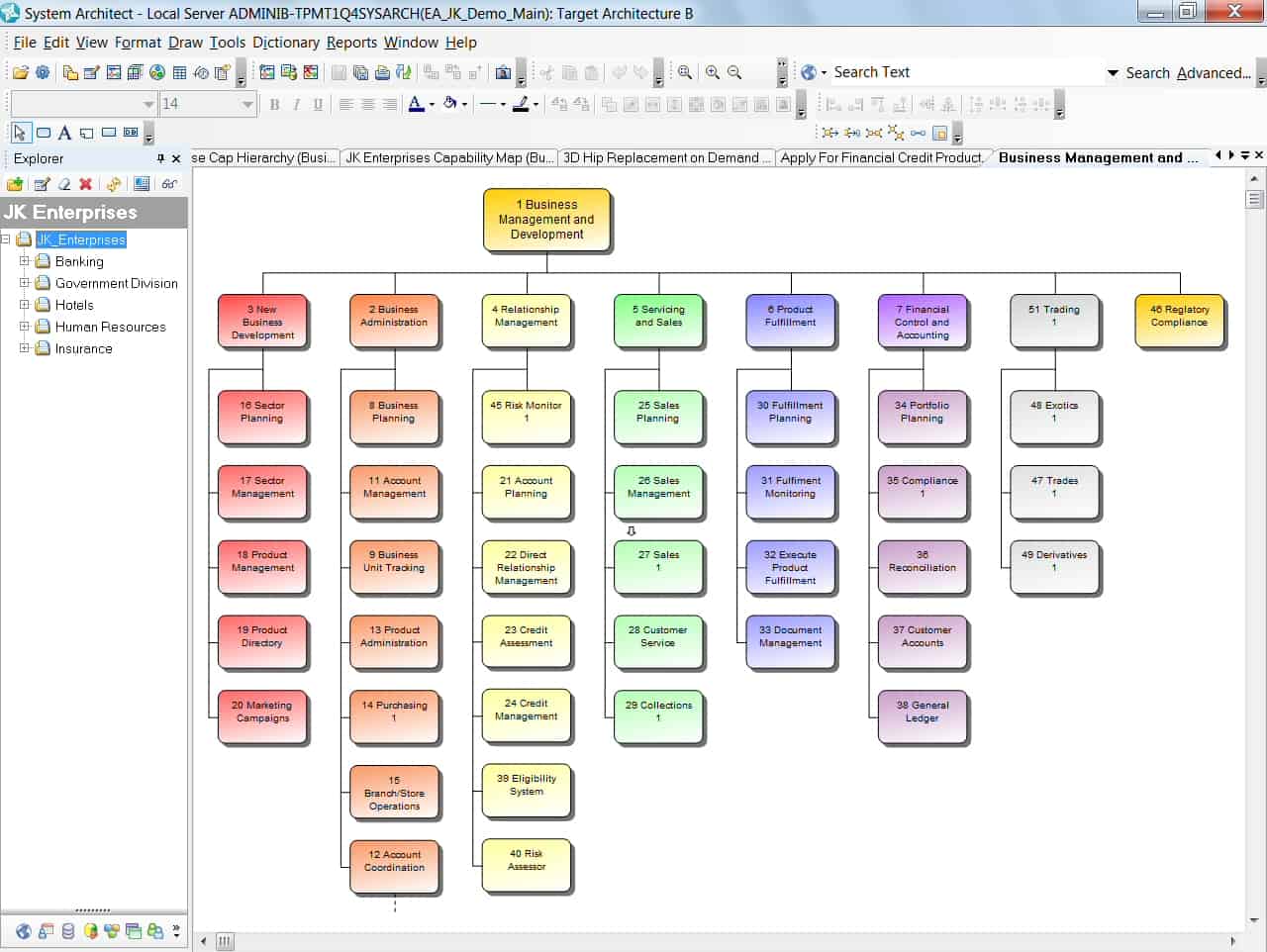
Document and Architect
Use industry-standard Business Process Modeling Notation (BPMN) 2.0 in System Architect or on the web in System Architect XT, to document existing processes or architect new ones. Model processes within the context of Enterprise Architecture to understand interdependencies amongst organization, data, services, applications, and technologies.

Simulate and Analyze
Using the SA Simulator Add-On, you can:
- Perform discrete-event simulation and animation of BPMN 2.0 and IDEF3 process flow diagrams
- Predict and highlight bottlenecks and utilization issues.
- Specify gateway decision paths based on probabilities, time in model, event based, object type, attribute, shortest queue, or time in model
- Specify arrival profile distributions (Beta, Erlang, Gamma, Log Normal, Negative Exponential, Normal, Truncated Normal, Triangle, Uniform, Weibull, Binomial, Poisson, Uniform, or User-Defined)
- Specify resource profiles and shift calendars to accurately portray operations.
- Calculate costs per transaction and per end-to-end process.
- Calculate operational risk values for regulatory requirements.
- Calculate expected failure rates and Six Sigma ratings.
- Automatically optimize the process flows to show best resource utilization.
Run Analytics
Analyze processes by running pre-built analytics or write your own on the fly in minutes using an analytics wizard. Understand who owns processes, where bottlenecks are, which processes are customer facing versus backend, which processes are key to the business, where inefficiencies lie, and what risk underlying technologies pose. Calculate the cost of processes using Activity Based Costing and/or Total Cost of Ownership algorithms.

Analyze Salesforce.com, SAP, and other ERP Systems
The SA ERP add-in enables you to reverse engineer ERP systems to analyze their data model tables, and their related application components and processes. Select important parts of the ERP data model (and its applications and processes) to import into System Architect, where its strong data modeling capabilities enable you to analyze the data model of the ERP system within the scope of the EA. Understand what processes act on what data in standard CRUD (Create, Read, Update, Delete) matrices.
Leverage Industry Reference Patterns
Jump start the architecture by reusing industry-standard patterns such as the TMForum Frameworx business process (eTOM), services (SID), and application portfolio (TAM). Or use the APQC processes to jump start your business process analysis.
Harvest Processes from BPA Tools Into the EA
Support for BPMN 2.0 interchange enables you model processes in System Architect, or harvest business processes from other point-solution business process tools.
Publish and Communicate
Use the SA Publisher add-on to build and gather reports to auto-generate sophisticated websites of the enterprise architecture so that you can communicate business processes and their context to everyone in the organization, producing greater efficiencies.
ERP Management
Analyze Salesforce.com, SAP, and other ERP Systems
UNICOM System Architect ERP (SA/ERP) is a meta-data discovery and management tool that enables you to extract, explore and analyze enterprise application meta-data. The SA/ERP add-in enables you to reverse engineer ERP systems to analyze their data model tables, and their related application components and processes. The following ERP systems are supported:
- Salesforce.com
- SAP
- Siebel
- J.D. Edwards
- PeopleSoft
- Oracle Enterprise Business Suite (EBS)
Looking Under the Hood of ERP Systems
The data structures of enterprise applications are complex and difficult to understand. Making sense of the meta-data hidden within your enterprise applications can be a time-consuming and frustrating task, especially when embarking on a project that requires specific knowledge of data structures. With SA/ERP, data managers can control meta-data without relying on enterprise application providers, this results in more consistent data, easier data migration, and cost savings. Select important parts of the ERP data model (based on their related applications or processes for example) to import into System Architect, where its strong data modeling capabilities enable you to analyze the data model of the ERP system within the scope of the EA. This is a feature unique in the enterprise architecture world.
Enterprise Data Management and Mapping
SA/ERP is the only tool on the market that extracts enterprise application meta-data solely for the purpose of exploration. It also links directly into your enterprise architecture for organizational analysis. It complements the existing UNICOM System Architect® repository, leaving you free to navigate complex ERP relationships with ease. Using SA/ERP, data managers can maintain control over the examination of meta-data and its results without reliance on enterprise application providers.
Meta-data Interrogation
With SA/ERP, you can perform customized queries on the existing ERP implementation, and allow for model search by common words or related artifacts. The queries can be saved into separate views for direct import into System Architect® and can be used for comparing process and applications with the architecture.
Meta-data Comparison
With SA/ERP, users can compare and contrast separate versions of ERP implementations and easily identify changes across the application meta-data. This capability enhances the management capabilities and decreases the level of effort required in ERP maintenance and deployment.
A Look Under the Hood of SA/ERP
Via SA/ERP's easy-to-use browser, users can navigate complex data structures - search for tables and fields, navigate up and down relationship paths, and search by application module. SA/ERP extracts key meta-data information (tables, fields, relationships, indexes, etc.) from the enterprise application data dictionary using the most appropriate connection mechanism for each enterprise application:
- Salesforce.com – SA/ERP uses direct SQL calls on the data dictionary
- SAP systems – SA/ERP uses RFC calls to an ABAP function
- J.D. Edwards – SA/ERP uses a combination of direct SQL calls to the data dictionary and an import of an XML file created by a J.D. Edwards-developed process
- PeopleSoft – SA/ERP uses direct SQL calls on the data dictionary
- Siebel – SA/ERP uses direct SQL calls on the data dictionary
- Oracle EBS -- SA/ERP uses direct SQL calls on the data dictionary
In each case, SA/ERP makes an initial connection to the system and then extracts the requested meta-data to a separate SA/ERP repository. So users work in an independent environment and make no further demands on the enterprise application team.
System Requirements
System Requirements
Before you install System Architect®, make sure that the system meets the requirements for hardware, software, server environment, operating systems, and other factors. The following table shows the minimum system requirements to install and use System Architect®. Check the compatibility between the operating systems, browsers, databases and the application servers before you install System Architect®.
Operating Systems:
| Windows | 7 | 8.1 | 10 | 2008 | 2008 R2 | 2012 | 2012 R2 | 2016 | 2019 |
| Datacenter | ✔ | ✔ | ✔ | ✔ | ✔ | ✔ | |||
| Enterprise | ✔ | ✔ | ✔ | ✔ | ✔ | ✔ | ✔ | ||
| Professional | ✔ | ✔ | ✔ | ||||||
| Standard | ✔ | ✔ | ✔ | ✔ | ✔ | ✔ |
Hypervisors:
VMware ESXi 5.0, 5.1, 5.5 & 6.0
VMware Workstation 10.0 & 11.0.
| Hardware | Requirement |
| Disk Space | 5.5 GB during installation and 1 GB after the install is complete |
| Display | Super VGA monitor (with the screen resolution set to at least 800 x 600, small fonts setting) |
| Memory | Minimum of 2 GB of RAM The main SA process (SA2001.EXE) will need at least 500MB to run efficiently, this usage can in some cases increase beyond that, hence the reason of recommending 1 GB of free RAM. Some actions that can increase the usage of RAM memory (but not limited to) are: -- Opening a lot of diagrams during the day and don’t close them, -- Opening a very large diagram, -- Very large import such as a very large mass update |
| Network: Adapters, Drivers & Protocols | Network throughput of at least 50 Mbps is required between each System Architect® client and the database server used to store the encyclopedias. |
| Processor | Pentium-class PC, 2 GHz or Higher |
Software
Databases
| Microsoft SQL Server | 2008 | 2008 R2 | 2012 | 2012 SP1 | 2014 | 2016 | 2017* |
| Enterprise Edition | ✔ | ✔ | ✔ | ✔ | ✔ | ✔ | ✔ |
| Developer Edition | ✔ | ✔ | ✔ | ✔ | |||
| Standard | ✔ | ✔ | ✔ | ✔ | ✔ | ✔ | |
| Express | ✔ | ✔ | ✔ | ✔ | ✔ | ✔ | ✔ |
| Web Edition | ✔ | ✔ | ✔ | ✔ |
*Windows installation only
Web Browsers (Required for SAXT and HTML reporting only)
Microsoft Internet Explorer 10 & 11
Mozilla Firefox ESR 68 and newer
Web Servers (Required for System Architect® XT installation only):
Microsoft Internet Information Services 7.0, 7.5, 8.0, 8.5 & 10.0
Training & Services
Training
UNICOM provides a range of flexible instructor-led training classes for System Architect. Choose from in-person sessions at our Training Facility at UNICOM Technology Park (UTP) in Chantilly, Virginia, convenient virtual training, or on-site training at your location.
Contact architect.sales@unicomsi.com for dates:
System Architect Fundamentals: 1-day hands-on course
Learn the fundamentals of System Architect including:
- How to build models with a data-centric and non-data centric approach
- How to build analytics on models
- How to build custom reports
- How to customize the metamodel
- How to publish models
DoDAF 2 with System Architect: 3-day hands-on course
Learn how to build DoDAF 2 architectures in System Architect, including:
- Capability-driven Architectures (CV)
- Operational Views (OV)
- Manually and Automatically creating Operational Exchanges and Needlines
- System Views (SV)
- Manually and Automatically creating System Exchanges and System Resource Flows
- Architecting the physical layer
- Data Information Views (DIV)
- Fit-for-Purpose Views
- Cause-effect analysis and heatmaps
- Project Planning (PV)
TOGAF 10 with System Architect: 3 day hands-on course
Learn how to build TOGAF 10 compliant, data driven viewpoints using System Architect, including:
- Phase A: Architecture Vision
- Phase B: Business Architecture
- Phase C: Application Architecture
- Phase C: Data Architecture
- Phase D: Technology Architecture
- Phase E: Opportunities and Solutions
- Phase F: Migration Planning
- Phase G: Governance
- Phase H: Change Management
System Architect Advanced: 2-day hands-on course
Learn System Architect advanced topics including:
- Administration of System Architect
- Using Workspaces to Maintain the Architecture
- Customizing the metamodel -- advanced
- Reporting -- advanced

In the United States, public training is provided at the following location:
UNICOM Technology Park I & II and Conference center
15000 Conference Center Drive
Chantilly, Virginia 20151
Services
UNICOM offers services for System Architect and enterprise architecture through a network of highly-skilled business partners; contact architect.sales@unicomsi.com for more information.
Evaluate
Hands-On Evaluation
To evaluate System Architect, please send an email to Architect.Sales@unicomsi.com. In the subject field ask for an Evaluation Request for System Architect. Sales will ask you for specific information to qualify you for the evaluation.
Request for Information
If you would like to submit a Request for Information for an Enterprise Architecture tool, please send an email to Architect.Sales@unicomsi.com.
Watch the Product In Action
Product Suite
System Architect
System Architect base product provides the following features:
- TOGAF
- Business Motivation Model (BMM)
- BPMN 2.0
- Logical and Physical Data Modeling
- Data Flow diagramming
- Capability Maps, Strategy Maps & Balanced Scorecards
- UML
- SOA design
- XML design
- Reporting System including dozens of pre-written reports
- Dashboard capabilities
- SA Compare
- Customizable metamodel
- Real-time multi-user capabilities
- Microsoft SQL Server Express for stand-alone work; users deploy full-blown Microsoft SQL Server to network for multi-user use.
DoDAF Add-In
The DoDAF Add-In is enabled with a DoDAF license. It provides the following additional features to the base System Architect product:
- DoDAF 2
- AV-1 thru AV-2 -- All Views
- CV-1 thru CV-7 -- Capability Views
- OV-1 thru OV-6 -- Operational Views (including BPMN for OV-5 and OV-6c)
- DIV-1 thru DIV-3 -- Data Information Views
- SV-1 thru SV-10 -- Systems Views
- SvcV-1 thru SvcV-10 -- Services Views
- StdV-1 thru StdV-2 -- Standards Views
- PV-1 thru PV-3 -- Project Views
- Fit-for-Purpose Views
- Unified Architecture Framework (UAF)
- Operational Views
- Project Views
- Resource Views
- Security Views
- Standards Views
- Strategy Views
- Services Views
- Summary Views
- Fit-for-Purpose Views
- DoDAF 1.5 standard
- DoDAF 1.5 Activity Based Method (ABM)
FEAF Add-In
The Federal Enterprise Architecture Framework (FEAF) Add-In is enabled with a FEAF license. It provides the following additional features to the base System Architect product:
- FEAF 2.0
- Automatic load of Consolidated Reference Model (CRM)
- Business Reference Model (BRM)
- Application Reference Model (ARM)
- Data Reference Model (DRM)
- Infrastructure Reference Model (IRM)
- Performance Reference Model (PRM)
- Security Reference Model (SRM)
- FEAF 2.0 Matrices
- Support for Consolidated Performance Method reports
- FEAF 1.0 (formerly called integrated Reference Model Architect (iRMA) in System Architect
- Support for FEAF 1.0 Consolidated Reference Model (CRM) with utilities for automatic import of the latest CRM from whitehouse.gov, automatic hierarchy creation of the CRM, alignment of investments to the CRM, matrices, and reports
NAF Add-In
The North Atlantic Treaty Organization (NATO) Add-In is enabled with a NAF license. It provides the following additional features to the base System Architect product:
- NAF 3.0
- NAV-1 thru AV-2 -- All Views
- NCV-1 thru NCV-7 -- Capability
- NOV-1 thru NOV-7 -- Operational Views
- NSV-1 thru NSV-12 -- Systems and Services Views
- NSOV-1 thru NSOV-5 -- Services Views
- NPV-1 thru NPV-2 -- Programme Views
- NTV-1 thru NTV-2 -- Technology Views
- NAF 1.0
- Constituant views of the older NAF 1.0, used mostly to open older architectures
MODAF Add-In
The Ministry of Defense Architecture Framework (MODAF) Add-In is enabled with a MODAF license. It provides the following additional features to the base System Architect product:
- MODAF 1.2
- AV-1 thru AV-2 -- All Views
- CV-1 thru CV-7 -- Capability
- OV-1 thru OV-7 -- Operational Views
- SV-1 thru SV-11 -- Systems Views
- SOV-1 thru SOV-5 -- Services Views
- StV-1 thru StV-6 -- Strategic Capability Views
- TV-1 thru TV-2 -- Technology Views
- AcV-1 thru AcV-2 -- Acquisition Views
SA XT
System Architect Xtended Team (XT) is a thin-client version of System Architect. It is a separate install to System Architect, but allows users to work int/view the same repository as users working with System Architect on the network -- but with SA XT the users are accessing the repository via a web client. SA XT is provided in the following license formats:
- SA XT read/write
- Browse the repository via a tree Explorer
- Add/edit/delete definitions
- View and zoom in/out of all types of diagrams
- Click on symbols to open their definitions
- Draw/edit BPMN and Org Chart diagram types
- View report dashboards served up live
- Create reports via a text editor
- SA XT readonly
- View live repository information
- Browse the repository via a tree Explorer
- View definitions (readonly)
- View and zoom in/out of all types of diagrams
- Click on symbols to open their definitions
- View report dashboards served up live
SA Publisher
The SA Publisher add-on enables you to:
- Generate a sophisticated, interactive, static website of the enterprise architecture so that an unlimited number of people may view the architecture on the web or intranet
- Group reports that you have created in System Architect, and publish them to the website, using css and xsl stylesheets.
- Browse the architecture in a tree explorer.
- View diagrams in SVG mode, where you can zoom in/out and click on symbols to open definitions.
- View diagrams in JPG mode for quick access across slow networks.
- View sophiscated reports that are the output of multiple reports to a single html page
- Save any page to Word, Excel, or PDF
- Email a reference to a page
- Create links for output pages to Microsoft Sharepoint or other intranet/document management systems.
- Click on links in the architecture artifacts of the website to other sources of record
SA Simulator
The SA Simulator add-on enables you to:
- Simulate and animate BPMN and IDEF3 process flows.
- Predict and highlight bottlenecks and utilization issues.
- Specify resource profiles and shift calendars to accurately portray operations.
- Calculate costs per transaction and per end-to-end process.
- Calculate operational risk values for regulatory requirements.
- Calculate expected failure rates and Six Sigma ratings.
- Run automatic Optimization of process flows for best use of resources.
SA ERP
The SA Enterprise Resource Planning (ERP) add-in enables you to reverse engineer, examine, and selectively import the table structure of the supported ERP systems (below) into a logical data model in System Architect. You may also use the tool to reverse engineer the application components and processes that the tables use. The supported ERP systems are:
- Salesforce.com
- SAP
- Siebel
- JD Edwards
- Peoplesoft
Capabilities
Repository
Use System Architect's robust EA repository:
- Collaborative, real-time, multi-user
- Role-based access control to instance level
- Single point of the truth
- Customizable metamodel so you can capture any and all corporate information
- Microsoft SQL Server Express for stand-alone work; users deploy full-blown Microsoft SQL Server to network for multi-user use.
- Easily create backups of EA repository database and maintain using industry-standard DB techniques
Architecting
Architect the enterprise with a data-centric approach using the following frameworks and methods:
- TOGAF
- DoDAF, NAF, MODAF
- Business Motivation Model (BMM)
- Capability Maps, Strategy Maps, and Balanced Scorecards
- Business Process Modeling Notation (BPMN 2.0)
- Relational Data Modeling
- UML
- Data Flow Diagramming
- Custom Frameworks and Diagrams
Patterns
Reuse industry standards such as:
- FEAF 2.0
- TM Forum Frameworx 14.5
- APQC
- BIAN
- SCOR
Analysis
Analyze the Enterprise Architecture with System Architect's:
- Visual Cause-Effect Analysis with Network Explorer diagrams
- Auto-creation of Landscape Analysis with Landscape Explorer diagrams
- Automatic Heatmap Analysis
- Gap Analysis
- Total Cost of Ownership
- Activity Based Costing
- Health of Architecture Analysis
Simulation
Use the SA Simulator add-on to:
- Perform discrete-event simulation and animation of BPMN 2.0 and IDEF3 process flow diagrams
- Specify gateway decision paths based on probabilities, time in model, event based, object type, attribute, shortest queue, or time in model
- Specify arrival profile distributions (Beta, Erlang, Gamma, Log Normal, Negative Exponential, Normal, Truncated Normal, Triangle, Uniform, Weibull, Binomial, Poisson, Uniform, or User-Defined)
- Predict and highlight bottlenecks and utilization issues.
- Specify resource profiles and shift calendars to accurately portray operations.
- Calculate costs per transaction and per end-to-end process.
- Calculate operational risk values for regulatory requirements.
- Calculate expected failure rates and Six Sigma ratings.
- Automatically optimize the process flows to show best resource utilization.
Metamodel
Capture any and all corporate information using the most flexible, customizable metamodel on the market:
- Create new properties, definition types, relationship types, symbol types, and diagram types
- Effect automatic rules such as data centric behavior for various diagram types (node symbol, hierarchical, symbol-inside-symbol)
- Inheritance based metamodel
- Create your own framework directly from SA's Meta Object Facility (MOF)
- Easy to customize yourself (no need for services); use GUI for metamodel additions
Harvesting Information
Automatically harvest information from disparate sources of record:
- Auto-import CSV or .XLS spreadsheets of information (applications, technologies) from IT or the business
- Import process models from other BPMN tools using BPMN 2.0 interchange
- Build custom importers using open API and VBA
- CMDB tools such as IBM Tivoli TADDM
ERP Analysis
Use the SA ERP add-on to:
- Reverse engineer and analyze salesforce.com, SAP, Siebel, JD Edwards, or Peoplesoft to understand the data tables and the application components and processes that use them
- Analyze the data models and selectively map data models into the EA in System Architect, where they form logical data models that can be analyzed within the context of the EA
Exporting Information
System Architect supports export of information to corporate intelligence portals:
- Auto-export CSV, XML, .BPMN 2.0 interchange
- REST read of repository to produce dashboards of EA information
Integrations
Create a federated approach to enterprise architecture information using System Architect's support for:
- Industry standard Open Services for Lifecycle Collaboration (OSLC) integrations for Architecture Management (AM), Change Management (CM), and Requirements Management (RM), enables integrations to many industry standard tools (see full list) including:
- Decision Analysis tools such as UNICOM Focal Point
- Requirements tools such as IBM DOORS Next Gen
- Change Management tools such as IBM Rational Team Concert (RTC) and Jira
- Architecture tools so you can govern solution design in products such as IBM Rational Software Architect
- Information-flow integrations to:
- UNICOM Focal Point
- IBM DOORS
- IBM Rational Software Architect
- Other custom integrations
Reporting
Analyze and report on the Enterprise Architecture through System Architect's reporting capabilities:
- An easy-to-use, native SQL-based Reporting System
- GUI that enables you to write your own reports in minutes
- Dozens of pre-built reports for all aspects of EA are provided, each easily tailored.
- Output to HTML, PDF, Grid user interface in SA itself, Excel, or D3 dashboards
- Native reports generated to Microsoft Word or Excel
- Auto-output of EA repository to ODS data source to query in 3rd party Business Intelligence tools such as IBM Cognos or Crystal Reports
Web Portal
Access/edit the Enterprise Architecture from the web through the following:
- SA XT for team members to edit the EA information via a web portal
- SA XT read for extended team users to view the live EA repository information and dashboards
- SA Publisher to produce sophisticated websites of the EA information so thousands of users can view it
EA Management
Manage the Enterprise Architecture through:
- As-Is and To-Be analysis with workspaces -- baseline the EA and create multiple side-by-side alternative scenario architectures
- Compare architectures in workspaces or in EA repositories to each other; selectively merge differences
Access Control
Have the System Architect administrator provide access rights to users and groups of users:
- Streamline the tool for end users by specifying role-based permissions to diagram types, definition types, menus, and instances of diagrams or definitions in a repository or workspace
Resources & Support
Support
If you are an existing customer, please join or log into the UNICOM Customer Support Portal for System Architect, where you will find latest help, tech support incidents, and detailed information about the product.
Data Sheets
Technical Papers
Defense Frameworks
UNICOM System Architect is a world-class leader supporting Defense Architecture Frameworks such as:
- DoDAF 2 -- the US Department of Defense Architecture Framework
- NAF 3 -- the NATO Architecture Framework
- MODAF 1.2 -- the UK Minstry of Defense Architecture Framework
With support for these frameworks, System Architect enables you to build capability-driven architectures that capture operational architecture, system-of-systems design, and integration, and perform project planning, both within and across organizations.

Customer quoteSystem Architect remains one of the most extensible architecture tools we have encountered with wide support of standard frameworks and notations such as DoDAF 2, TOGAF, UPDM and BPMN 2.0. The flexibility to "bridge the gap" between internal and external architecture implementations through a customizable and extensible meta model and user defined properties is a huge bonus."
Gartner's Peer Insights program
Build Architectures with DoDAF 2 Data Centric Approach
The enterprise architecture repository becomes a single source of the truth, with a data centric approach so that all diagram views and matrices represent the architecture information. Whether you are viewing a diagram of symbols inside other symbols, a hierarchy node-tree view, a matrix, or a standard node-symbol diagram -- the model remains king -- diagrams reflect the underlying architecture information and its relationships, and vice versa -- diagrams act as information portals to create or edit the architecture. System Architect implements the DM2 directly, with inheritance in its metamodel and UML-type diagrams for viewpoints.
With the data centric approach, you can quickly build viewpoints from sources of record -- import a csv spreadsheet of information, drop architecture elements onto a diagram with relationships auto-drawn. Easily navigate the architecture to see what parts of the architecture reference or use other parts.

System Architect supports all 52 DoDAF 2 views with data-centric, model-based behavior. Here the OV-5b shows how Resources flow thru and get transformed by Operational Activities, and what Performers perform those Activities while the OV-5a shows the hierarchy of Operational Activities.
Capability-Based Planning and Project Views
Build capability-driven architectures to get a line of sight on how capabilites are enabled across commands. Build project views and roadmaps on how capabilities will be enabled over time, by different systems, and understand the risk to capabilities due to system lifecycle states. Map project views from System Architect into UNICOM Focal Point using the integration between the tools, for non-architectural project and portfolio management. Auto-build System roadmaps with SV-8 views or technology forecasts SV-9 views.
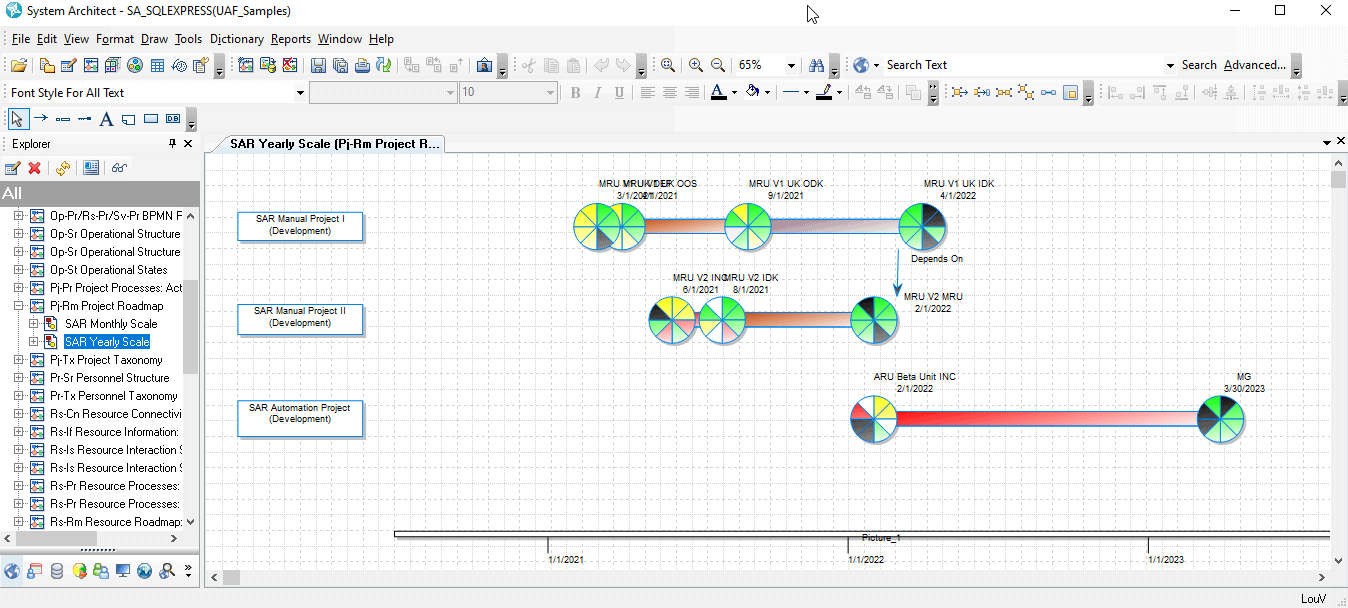
BPMN Integrated with the DM2
The System Architect team provided industry thought-leadership in being the first to implement the Business Process Modeling Notation (BPMN 2.0) to directly visualize the DM2 for OV-5 viewpoints, as well as OV-6c process flow viewpoints.
Automatic Generation of Inferred Architecture Information
System Architect also provides industry thought-leadership in automatic, intelligent generation of Operational Exchanges, Needlines, System Exchanges, and System Resource Flows from inferred information in the architecture. You can maintain automatic generation and/or manually add such relationships to the architecture, working in a mixed automatic and manual mode.
Autogenerate AV-2, OV-3 and SV-6 Reports
Autogenerate standard DoDAF reports such as the AV-2, OV-3, or SV-6 -- or create your own reports on the fly in minutes with System Architect's easy to use native SQL reporting system.

Fit-for-Purpose Views
Customize the metamodel to properly capture information in sources of record, and to visualize the information in different ways. System Architect is unmatched in the industry for its ability to customize its metamodel to great breadth, depth, and ease. Create new fit-for-purpose viewpoints -- new diagram types, symbol types, definition types, properties, relationships, and data centric rules.

Cause-Effect and Landscape Heatmap Analysis
Quickly get a 50,000-foot view of the architecture through System Architect's unique Network- and Landscape-style Explorer diagrams, that allow you to auto-visualize reports showing calculated (inferred) relationships between EA artifacts. For example, visualize what Capabilities are put at risk by Systems utilizing technologies that have a security risk -- either as a network showing traceability, or a landscape heatmap with Systems placed inside the Capabilities they enable (and not showing the in-between element types). The EA world is your oyster with Explorer diagrams, which enable you to create visualizations of any combination of architecture elements on the fly in minutes.
Build and Compare Current State & Future State Architectures
You can baseline your architecture and create multiple side-by-side future-state architectures using a feature called workspaces, which are layers of the architecture. You can compare and merge workspaces, and at some point baseline a desired future-state architecture to become a new current state, and create new future-state architectures. Workspaces enable different departments to work on the architecture independently, and then merge their work into the corporate EA.
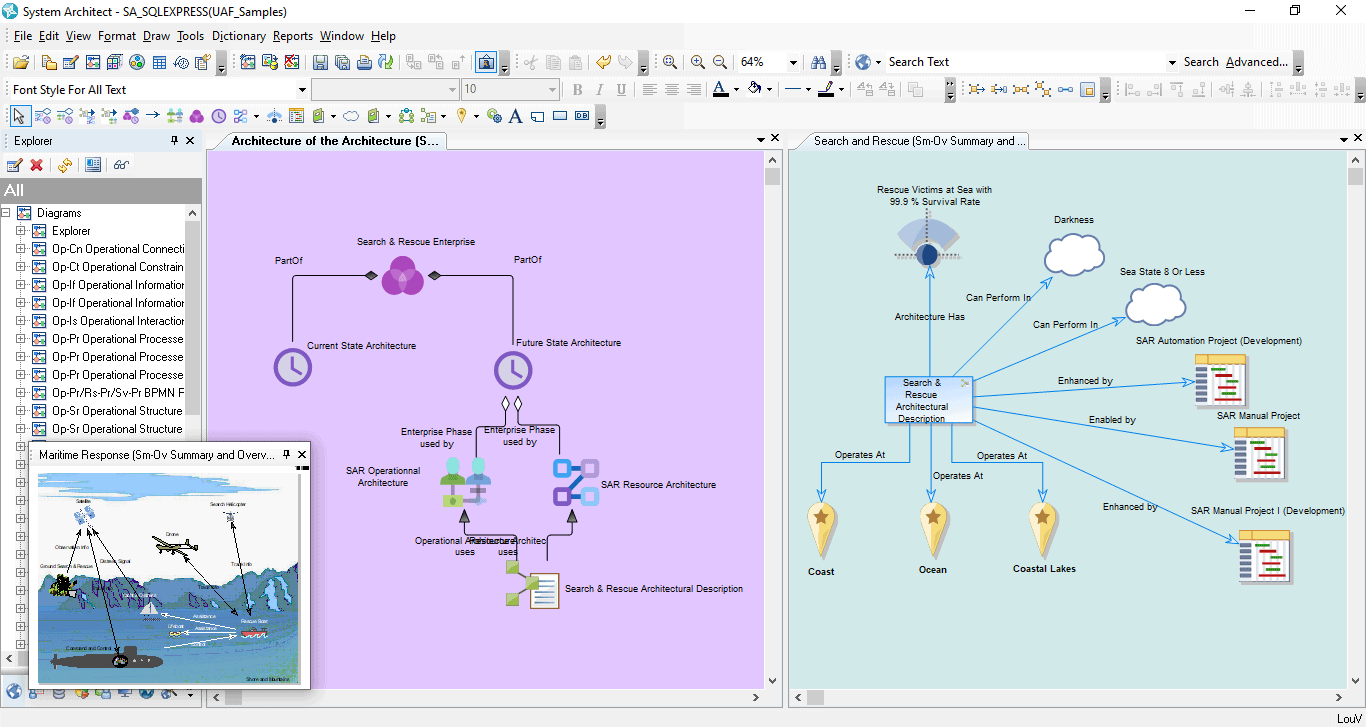
Link the Architecture with Requirements, Change Management, and Solution Design
System Architect is the cornerstone of an Architecture strategy, empowering organizations to expand the value of EA to a broader set of stakeholders and projects within the organization. System Architect is a central piece of an interconnected eco-system that includes portfolio management, solution design, asset management, governance, requirements management, operations management, business process modeling, business intelligence, service management, and change management, all of which are key to driving value. Integrations amongst these tools are now provided via Open Services for Lifecycle Collaboration (OSLC) technology
DoDAF 2 Migration Toolkit
Migrate DoDAF 1.5 architectures to DoDAF 2 using the free DoDAF 2 Migration Toolkit, available for download from the UNICOM customer support portal.
Defense Architecture Capabilites
DoDAF Add-In
The DoDAF Add-In is enabled with a DoDAF license. It provides the following additional features to the base System Architect product:
- DoDAF 2
- AV-1 thru AV-2 -- All Views
- CV-1 thru CV-7 -- Capability Views
- OV-1 thru OV-6 -- Operational Views (including BPMN for OV-5 and OV-6c)
- DIV-1 thru DIV-3 -- Data Information Views
- SV-1 thru SV-10 -- Systems Views
- SvcV-1 thru SvcV-10 -- Services Views
- StdV-1 thru StdV-2 -- Standards Views
- PV-1 thru PV-3 -- Project Views
- Fit-for-Purpose Views
- Automatic generation of Operational Exchanges, Needlines, System Exchanges, and System Resource Flows
- Interoperable matrices such as CV-5, CV-6, OV-3, SV-3, SV-5a, SV-5b, SvcV-5a, and SvcV-5b
- Automatic generation of DoDAF 2 reports such as AV-2, CV-3, OV-3, SV-3, SV-6, SvcV-6, PV-3, StdV-1, and StdV-2
- Integrations with IBM DOORS and other requirements tools
- Integration with change management, and architecture tools
- Unified Architecture Framework (UAF)
- Operational Views
- Project Views
- Resource Views
- Security Views
- Standards Views
- Strategy Views
- Services Views
- Summary Views
- Fit-for-Purpose Views
- DoDAF 1.5 standard
- DoDAF 1.5 Activity Based Method (ABM)
NAF Add-In
The North Atlantic Treaty Organization (NATO) Add-In is enabled with a NAF license. It provides the following additional features to the base System Architect product:
- NAF 3.0
- NAV-1 thru AV-2 -- All Views
- NCV-1 thru NCV-7 -- Capability
- NOV-1 thru NOV-7 -- Operational Views
- NSV-1 thru NSV-12 -- Systems and Services Views
- NSOV-1 thru NSOV-5 -- Services Views
- NPV-1 thru NPV-2 -- Programme Views
- NTV-1 thru NTV-2 -- Technology Views
- NAF 1.0
- Constituant views of the older NAF 1.0, used mostly to open older architectures
MODAF Add-In
The Ministry of Defense Architecture Framework (MODAF) Add-In is enabled with a MODAF license. It provides the following additional features to the base System Architect product:
- MODAF 1.2
- AV-1 thru AV-2 -- All Views
- CV-1 thru CV-7 -- Capability
- OV-1 thru OV-7 -- Operational Views
- SV-1 thru SV-11 -- Systems Views
- SOV-1 thru SOV-5 -- Services Views
- StV-1 thru StV-6 -- Strategic Capability Views
- TV-1 thru TV-2 -- Technology Views
- AcV-1 thru AcV-2 -- Acquisition Views
Respository
Use System Architect's robust EA repository:
- Collaborative, real-time, multi-user
- Microsoft SQL Server Express for stand-alone work; users deploy full-blown Microsoft SQL Server to network for multi-user use.
- Role-based access control to instance level
- Single point of the truth
- Customizable metamodel so you can capture any and all corporate informatoin
- Easily create backups of EA repository database and maintain using industry-standard DB techniques
Analysis for Fit-for-Purpose Views
Analyze the Enterprise Architecture with System Architect's:
- Visual Cause-Effect Analysis with Network Explorer diagrams
- Auto-creation of Landscape Analysis with Landscape Explorer diagrams
- Automatic Heatmap Analysis
- Gap Analysis
- Total Cost of Ownership
- Activity Based Costing
- Health of Architecture Analysis
Metamodel Customization for Fit-for-Purpose Views
Develop Fit-for-Purpose Views by capturing any and all organizational information using the most flexible, customizable metamodel on the market:
- Create new properties, definition types, relationship types, symbol types, and diagram types
- Effect automatic rules such as data centric behavior for various diagram types (node symbol, hierarchical, symbol-inside-symbol)
- Inheritance based metamodel
- Create your own framework directly from SA's Meta Object Facility (MOF)
- Easy to customize yourself (no need for services); use GUI for metamodel additions
Integrations
Create a federated approach to enterprise architecture information using System Architect's support for:
- Industry standard Open Services for Lifecycle Collaboration (OSLC) integrations for Architecture Management (AM), Change Management (CM), and Requirements Management (RM), enables integrations to many industry standard tools (see full list) including:
- Decision Analysis tools such as UNICOM Focal Point
- Requirements tools such as IBM DOORS Next Gen
- Change Management tools such as IBM Rational Team Concert (RTC) and Jira
- Architecture tools so you can govern solution design in products such as IBM Rational Software Architect
- Information-flow integrations to:
- UNICOM Focal Point
- IBM DOORS
- IBM Rational Software Architect
- Other custom integrations
Reporting
Analyze and report on the Enterprise Architecture through System Architect's reporting capabilities:
- An easy-to-use, native SQL-based Reporting System
- GUI that enables you to write your own reports in minutes
- Dozens of pre-built reports for all aspects of EA are provided, each easily tailored.
- Output to HTML, PDF, Grid user interface in SA itself, Excel, or D3 dashboards
- Native reports generated to Microsoft Word or Excel
- Auto-output of EA repository to ODS data source to query in 3rd party Business Intelligence tools such as IBM Cognos or Crystal Reports
Web Portal
Access/edit the Enterprise Architecture from the web through the following:
- SA XT for team members to edit the EA information via a web portal
- SA XT read for extended team users to view the live EA repository information and dashboards
- SA Publisher to produce sophisticated websites of the EA information so thousands of users can view it
EA Management
Manage the Enterprise Architecture through:
- As-Is and To-Be analysis w workspaces -- baseline the EA and create multiple side-by-side alternative scenario architectures
- Compare architectures in workspaces or in EA repositories to each other; selectively merge differences
Access Control
Have the System Architect administrator provide access rights to users and groups of users:
- Streamline the tool for end users by specifying role-based permissions to diagram types, definition types, menus, and instances of diagrams or definitions in a repository or workspace
Defense Architecture Resources
FEAF
The United States Office of Management and Budget (OMB) created the Federal Enterprise Architecture Framework (FEAF) as a mechanism to identify duplication of assets, within and outside of each US Government agency, so that departments can be cost effective in reuse or procurement of new technology investments.
FEAF 2 establishes a common language Consolidated Reference Model (CRM) to help identify assets across agencies, and a Collaborative Planning Method (CPM) to standardize the process agencies and departments must do to establish the need for a new investment.
FEAF is also popular amongst commercial corporations, who utilize the exhaustive reference models as a starting point in their EA efforts.

The System Architect FEAF 2 add-in enables organizations to utilize the latest CRM, align architecture to the reference models, and generate automated reports to help with the CPM process, while harnessing other powerful features of the repository-based EA solution.
Reference Model Management
Automatically load the latest CRM, including the Business Reference Model (BRM), Application Reference Model (ARM), Data Reference Model (DRM), Infrastructure Reference Model (IRM), Performance Reference Model (PRM), and Security Reference Model (SRM). Auto-visualize the reference model hierarchies. Manage the reference models in a multi-user repository based on an industry-standard database.
Supporting the Collaborative Planning Methodology
Describe and align assets to the CRM through definitions or via a set of FEAF 2 matrices. Use TOGAF asset types, DoDAF 2 asset types, or asset types established by your own metamodel. Create a CPM line of sight -- understand owners, sponsors, and stakeholders; needs and gaps, candidate need gap providers, and output measures. Align investments to the agency strategies using the Business Motivation Model (BMM).
OMB Reporting and Analysis
Out-of-box reports are provided to publish asset categorizations and CPM line of sight views. Build integrated plans and transition plans, and auto-generate roadmaps of capabilities, services, applications, technologies, or any enterprise artifact.
Utilize a Repository-Based, Data-Centric Approach
The enterprise architecture repository becomes a single source of the truth, harvesting information from disparate sources of record, with a data centric approach so that all diagram views and matrices represent your organizational information.
Build and Compare Current State & Future State Architectures
Baseline your enterprise architecture and create multiple side-by-side future-state architectures using a feature called workspaces, which are layers of the architecture. You can compare and merge workspaces, and at some point baseline a desired future-state architecture to become a new current state, and create new future-state architectures. Workspaces enable different departments to work on the architecture independently, and then merge their work into the corporate EA.
Perform Application Portfolio Analysis
Utilize out-of-box analytics to visualize portfolio analysis or write your own analytics on the fly in seconds using a wizard front end to the built-in SQL reporting system. Map decision analysis results into System Architect from UNICOM Focal Point using the integration between the tools, or map in APM measures from other industry-leading Project and Portfolio Management tools.
Integrate to Solution Design, Requirements, and Change Management
System Architect is one of the few enterprise architecture tools to embrace and implement Open Service for Lifecycle Collaboration (OSLC) standards. You can create traceability links between the architecture and related aspects of enterprise information such as requirements, change requests, action items, or solution designs in other architecture tools. A simple right-mouse click enables you to see information in other 'friend' tools across the network and create links to relevant artifacts in them, then see and navigate those links at any time. OSLC creates a federated picture of organizational information and helps make Enterprise Architecture more valuable, helping you take it out of its ivory tower. Use this traceability to govern solution design, and align to the DevOps processes of release management, testing, and deployment.
Web Based
Use the SA Publisher add-on to build and gather reports to auto-generate sophisticated websites of the enterprise architecture so that you can communicate business processes and their context to everyone in the organization, producing greater efficiencies. Use SA XT for live read/write web access to the repository.
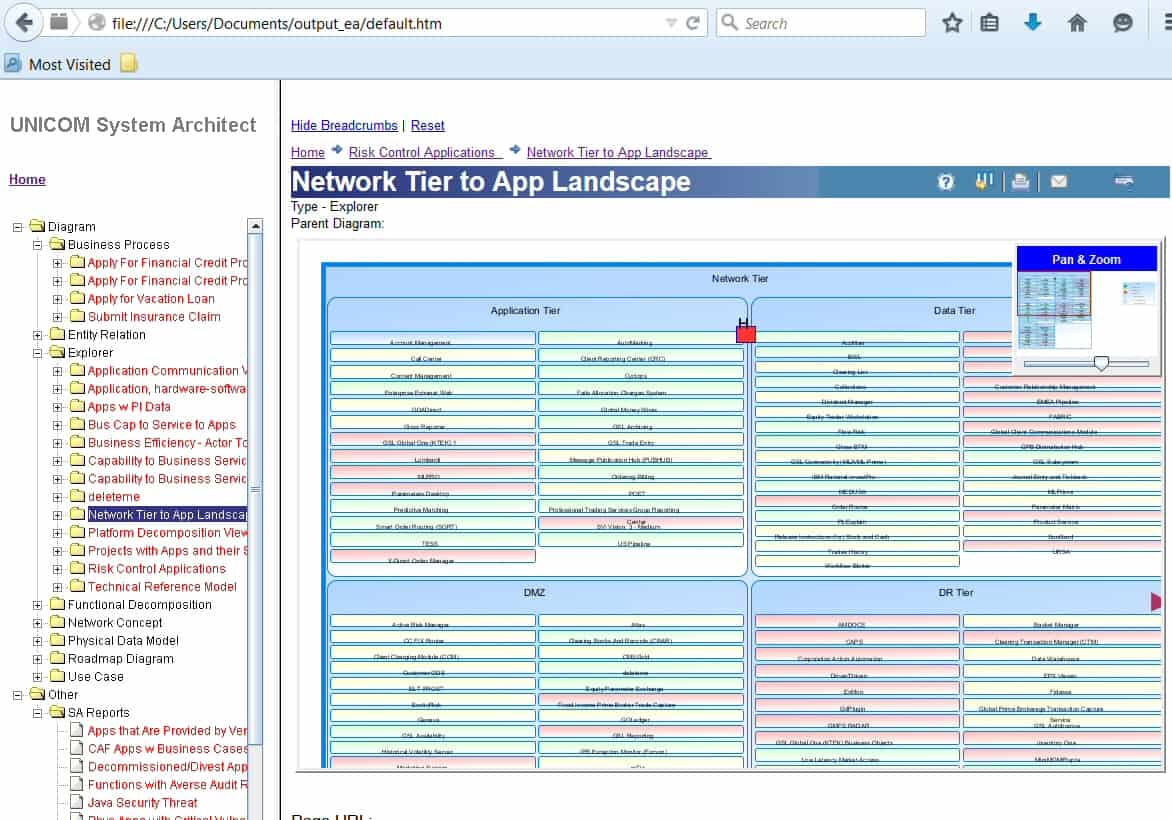
SA Publisher generates a sophisticated website of the architecture allowing an unlimited number of people to view the architecture
FEAF Add-In Details
FEAF Add-In
The Federal Enterprise Architecture Framework (FEAF) Add-In is enabled with a FEAF license. It provides the following additional features to the base System Architect product:
- FEAF 2.0
- Automatic load of Consolidated Reference Model (CRM)
- Business Reference Model (BRM)
- Application Reference Model (ARM)
- Data Reference Model (DRM)
- Infrastructure Reference Model (IRM)
- Performance Reference Model (PRM)
- Security Reference Model (SRM)
- FEAF 2.0 Matrices
- Support for Consolidated Performance Method reports
- FEAF 1.0 (formerly called integrated Reference Model Architect (iRMA) in System Architect
- Support for FEAF 1.0 Consolidated Reference Model (CRM) with utilities for automatic import of the latest CRM from whitehouse.gov, automatic hierarchy creation of the CRM, alignment of investments to the CRM, matrices, and reports
EA & Portfolio Management
Assessment of your application and technology portfolio is best performed when you integrate portfolio analysis with enterprise architecture -- allowing you to understand the impact of changes before making decisions. Then you can build transition plans and manage your project portfolio to bring the organization to new, more efficient levels.
UNICOM Focal Point™ enables you to do a thorough analysis of your Information Technology (IT) portfolio against non-architectural data points such as costs, development bandwidth, or survey results. The System Architect®-Focal Point™ integration enables you to take those results and bank them off of the enterprise architecture, so you can do visual analytics on the architecture, and quickly understand how changes to the IT landscape will affect business owners, processes, services, and capabilities.
Application Portfolio Management
Rapidly create an application inventory in either System Architect or Focal Point. Map applications to Focal Point and run pre-provided reports to analyze and assess applications based on business and IT value, improvement potential, and risk. Score applications against defined, prioritized, and weighted business and technical criteria. Determine what applications should be moved to the cloud, rearchitected for the cloud or mobile, retired, sustained, enhanced, consolidated, or replaced. Determine what applications should be developed as new mobile, cloud-aware, or cloud-native apps and what apps should be purchased.
Then bank the analysis results off of the application inventory in System Architect using the Focal Point-System Architect integration, visualize the APM results as analytics on the architecture, and do cause-effect analysis on the business. Create roadmaps for change. Assess the technical and business impact of application change. Select and plan portfolio transformation initiatives, such as projects for decommissioning or modernizing applications.
Technology Portfolio Management
Understand how changes to your application portfolio impact your technology portfolio -- and vice versa. Use the enterprise architecture to assess what technologies are being used in applications and systems across the organization, where they are being used, and what effects technology risks have on the business.
Identify technology innovations that can provide new capabilities for the business. In Focal Point, assess new technologies and do trade-off analysis of their features, benefits, costs and market acceptance. Back in System Architect, use the EA to help implement governance of chosen technology standards. Then build roadmaps of new technologies, their projected costs, and the capabilities they will provide.
Project Portfolio Management
Use enterprise architecture to move project portfolio management out of its vacuum. Align projects and sub-projects to the capabilities they enable, the business strategies they support, and the IT portfolio they change. Map the projects to Focal Point, where your steering committe canprioritize projects based on predefined sets of criteria such as strategic fit, architectural fit, business risk, budget constraints, manpower constraints, targeted portfolio reductions, cost savings, or your own attribute set. Identify which projects are higher priority based on the needs of the business, and determine the best project portfolio mix given the constraints of manpower and costs.
Map the analysis from Focal Point back to the enterprise architecture, use analytics to visualize the project portfolio analysis, and assess the cause-effect of prioritorized projects on the enterprise. Armed with this information, you have a much higher degree of confidence for what transformation projects to pursue.
Products
System Architect
System Architect base product provides the following features:
- TOGAF
- Business Motivation Model (BMM)
- BPMN 2.0
- Logical and Physical Data Modeling
- Data Flow diagramming
- Capability Maps, Strategy Maps & Balanced Scorecards
- UML
- SOA design
- XML design
- Reporting System including dozens of pre-written reports
- Dashboard capabilities
- SA Compare
- Customizable metamodel
- Real-time multi-user capabilities
- Microsoft SQL Server Express for stand-alone work; users deploy full-blown Microsoft SQL Server to network for multi-user use.
Add-ons
- DoDAF 2, NAF 3, MODAF 1.2, DoDAF 1.5 ABM
- ArchiMate 3
- FEAF 2
- SA XT live web architecture capabilities
- SA Publisher architecture website generation capabilites
- SA Simulator to simulate and optimize process flows
- SA ERP to harvest ERP systems
Focal Point
Focal Point provides the following features:
- Application Portfolio Management
- IT Portfolio Management
- Product Delivery Management
- Project Portfolio Management
- Product Management
- Harvesting Techniques:
- Web-based portal for input by employees or customers
- Excel import/export
- Microsoft Word Import
- Email Import
- Analysis Techniques:
- Pairwise comparison
- Investment analysis
- Financial planning using Time Grid Attribute
- Dashboard Charts:
- Roadmaps and Gantt Charts
- Gantt Chart Histogram
- Bubble Chart
- Stacked XY or Bubble Charts
- Bar Chart
- Stacked Bar Chart
- Ranking schemes
- Stacked Bar Chart
- Pie Chart
- Radar Chart
- Waterfall Chart
- Roadmaps and Gantt Charts
SA-Focal Point Integration
Integration provides mapping-of-data capabilites between the tools.
- Map System Architect definitions and properties to Focal Point modules and attributes, respectively
- Map System Architect definitions and properties to Focal Point criteria and attributes, respectively
- Map Focal Point modules and attributes to System Architect definitions and properties, respectively
- Map Focal Point criteria and attributes to System Architect definitions and properties, respectively
SA-Focal Point OSLC Integration
Provides ability to link an artifact in System Architect to an artifact in Focal Point, via the OSLC CM specification.
Capabilities
SA-Focal Point Integration
Provides the following mapping-of-data capabilities between the tools:
- Map System Architect definitions and properties to Focal Point modules and attributes, respectively
- Map System Architect definitions and properties to Focal Point criteria and attributes, respectively
- Map Focal Point modules and attributes to System Architect definitions and properties, respectively
- Map Focal Point criteria and attributes to System Architect definitions and properties, respectively
- Both products have customizable metamodels -- so you can extend each to accomodate your architecture types and property types
- Mapping provided:
System Architect Focal Point Encyclopedia Workspace Encyclopedia Workspace Workspace Definition Module, Criteria Property Attribute Access Control Feature View
OSLC Integration
Provides ability to link an artifact in System Architect to an artifact in Focal Point, via the OSLC CM specfiication.
Resources
Technical Papers


